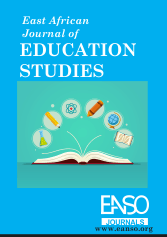Evaluating Teaching Practice in Kenya: Successes and Failures
Abstract
Although there have been significant reforms, Kenya's education system still faces many obstacles. Inadequate funding, an ongoing teacher shortage, and opposition to educational reform are substantial problems that impede the achievement of academic objectives and student results. This study thoroughly analyses Kenya's educational landscape, considering professional development, CBC implementation, technology integration, teacher preparation, and assessment techniques. The study provides a nuanced analysis of Kenya's educational landscape by identifying successes and challenges within these domains. The study adopts a qualitative approach, including a thematic analysis of qualitative data, secondary data analysis, and a literature review. Government reports scholarly works and international evaluations are examples of secondary data sources that offer a solid basis for the study. The results indicate that professional development initiatives have significantly improved teacher competencies and instructional practices. The CBC has received positive feedback for integrating practical skills and critical thinking into the curriculum. Technology integration has improved student engagement and interactive learning, as demonstrated by programmes such as the Digital Literacy Programme. Still, there are enduring difficulties. Effective teaching is hampered by a lack of resources, made worse by a shortage of teachers and unequal access to technology, especially in rural areas. Educator resistance to implementing new curricula and methods makes reform initiatives even more challenging. Kenya's education system still faces significant obstacles that must be overcome to improve instructional strategies. Sustained improvement requires addressing teacher shortages, improving resource allocation, and overcoming resistance to change. These efforts are crucial to ensure equitable access to quality education and prepare students for future difficulties. The study recommends increasing funding and equitable distribution of resources to enhance infrastructure and teaching materials; implementing strategies to recruit and retain qualified teachers, providing ongoing professional development; expanding access to technology and providing comprehensive training for educators to maximize its educational benefits; fostering a culture of innovation through awareness programs, incentives for educators, and collaborative policymaking. This article intends to add to the continuing discourse on educational reform in Kenya, presenting insights and ideas to guide policy decisions and create positive change in the education sector
Downloads
References
Commission on Teacher Service (TSC). (2020). The Teacher Professional Development Annual Report.
Curriculum Development Institute of Kenya (KICD). (2017). Framework for Competency-Based Curriculum.
Global Bank. (2020). 2018 World Development Report: Unlocking the Potential of Education.
Global Bank. 2018). Education Sector Review in Kenya.
Kenyan Ministry of Education. (2021). Report on Programme Evaluation for Digital Literacy.
OECD. (2019). Results of the 2018 Teaching and Learning International Survey (TALIS).
Sahlberg, P. (2015). Finnish Lessons 2.0: What can the world learn from educational change in Finland? (2nd ed.). New York, NY: Teachers College Press.
UNEP. (2018).). A Comparative Study of Fundamental e-Readiness in Schools Using ICT in Sub-Saharan Africa.
UNEP. (2020). Kenya Chapter of the Global Education Monitoring Report.
Union Africana. (2016). The Africa Continental Education Strategy (CESA 16–25) runs from 2016 to 2025.
World Bank (2018). World development report 2018: Learning to realize education’s promise. https://www.worldbank.org/en/publication/wdr2018
Copyright (c) 2024 Betty Cheruiyot, PhD

This work is licensed under a Creative Commons Attribution 4.0 International License.




























